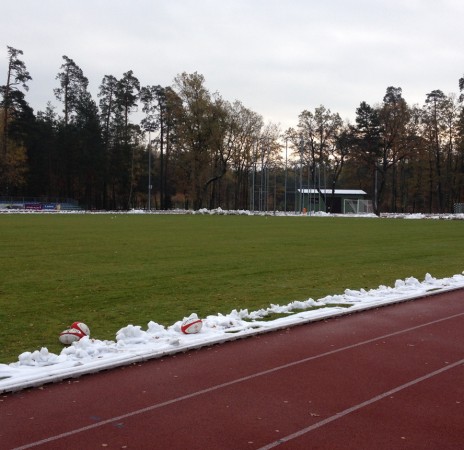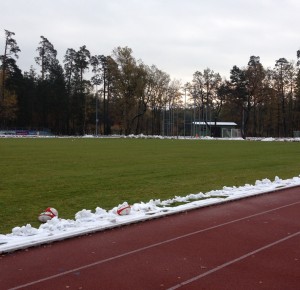
Cool runnings: the Wales players get stuck into an intense training session in Poland Pic: Huw Evans Agency
By Sarah Mockford, Rugby World Features Editor
I’D ALMOST forgotten about the flashlight app I’d downloaded onto my phone a few months ago on the recommendation of a friend – but then I hadn’t envisaged that one evening I’d be traipsing through a Polish wood in the pitch black hunting out Wales’ training camp.
A select band of journalists had been invited to Spala in Poland by the WRU to see exactly what Wales got up to when locked away in the town’s Olympic training centre. A few minutes after checking into our downtown hotel – or was it uptown? The main street’s only half a mile long! – there was a call to say we were welcome to pop in to see the players doing a weights session.
The directions seemed pretty straightforward: right out of the hotel then 700 yards up the road, so off we toddled. Soon, though, the pavement ended, the street lights disappeared and darkness enveloped the area – did we plough on or go back to check we were heading in the right direction? After consulting a local restaurateur, we set off into the wooded area to the side of the road. That’s when the flashlight proved invaluable, helping us to avoid the numerous trip hazards en route.
There was a sense of relief when we saw the Centralny Osrodek Sportu driveway and soon we were ensconced in the testosterone-heated gym, watching players pump iron to pumping beats. At one point Bradley Davies nonchalantly picked up a large weight plate with one hand. I tried it (after the players had left of course) and could barely lift it a couple of inches with both hands!
Now familiar with the route, the following day we headed to Wales’ base at 6am to watch their swimming session. Lengths and sprinting under water were on the agenda – the aim to keep the players working when fatigued, as they have to in a match.
Breakfast was next, followed by specific backs and forwards rugby sessions, and then came the first of the day’s two trips to the cryotherapy chamber. I’d previously tried out the mobile cryo ‘pod’ Wales used during the Six Nations and hadn’t found it too bad, so I thought I’d give it a go. Kitted out in the regulation shorts, socks, gloves, headband and face mask, a pair of white clogs completing the rather unfashionable look, I had my blood pressure taken and headed in.
It was completely different to my earlier taste of cryotherapy, where your head remains outside the pod. Here the dense fog makes it hard to see even a few inches in front of you and towards the end of the two-and-a-half minutes spent at -130 degrees (the players stay in longer at lower temperatures) the exposed parts of my thighs were starting to feel the pain, like an intense pins and needles.
Still, once released from the chamber the pain quickly dissipated and we headed to an exercise bike. It’s the same process the players follow as the exercise flushes the toxins out of the system, as well as providing another cardio workout.
After lunch, the whole squad headed to the main pitch. It was high-octane stuff, the players not holding back as they switched from skills work to touch games, the intensity always high. The whistle blew after 41 minutes – purposely done to match the average ball-in-play time in a Test – and after a quick breather they launched into an exhausting fitness drill. Players sprint the length of the pitch six times but the run is interspersed with dives onto the ground, making it even more difficult. The fact they’re split into positional groups adds a competitive edge – Leigh Halfpenny was keeping a close eye on Harry Robinson, wanting to stay in front of him, while Lloyd Williams and Justin Tipuric almost made it look easy.
There were plenty of deep breaths after that drill but the players were encouraged to stand up and not put their hands on their hips – such body language in a game could give the opposition a boost. Rather than rest, the players headed straight to the gym for weights, chucking medicine balls around like they were beach balls. Then came a spot of wrestling, with wedgies a common side-effect and Matthew Rees ready to give Maria Sharapova a run for her money in the grunting stakes. The day is wrapped up by another round of cryotherapy, dinner and more weights.
As Adam Beard, the WRU’s head of performance, says: “When we first came here it was us cracking the whip. Now the culture drives that. This group is so motivated, it’s a privilege to work with them.”
Things eventually come to a halt at 8pm. I’m shattered – and I’ve just been watching. There’s no rest for the players, though. They have to make these conditioning sessions count in the autumn Tests, while I’ll be giving my fingers a workout from the press box.







